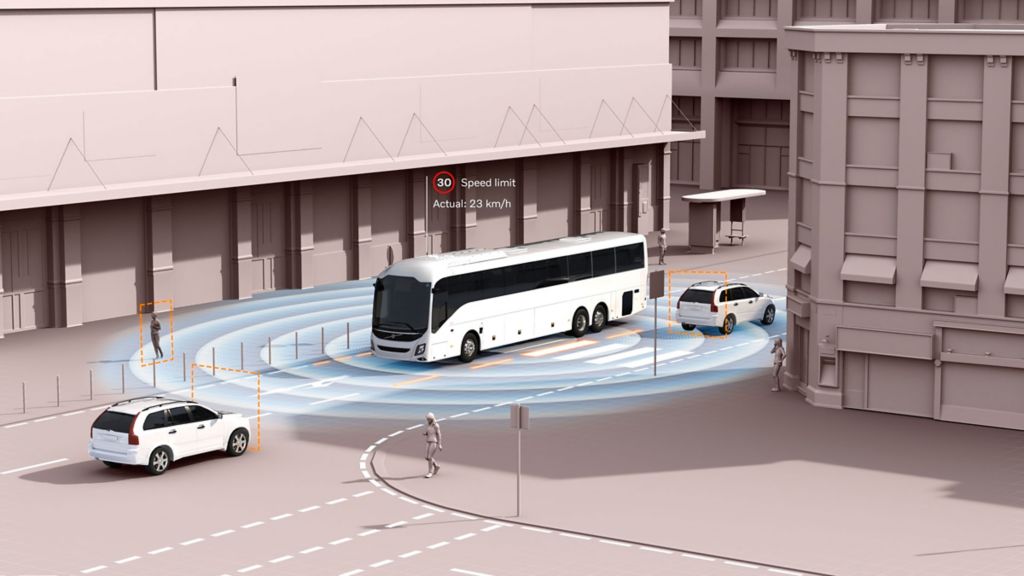Volvo Buses announces global launch of third-generation active safety systems – improving safety for vulnerable road users


At Volvo, safety never stops at good enough. Exceeding the safety regulations has become a Volvo Buses hallmark – even for the new active safety features.
“One example is our emergency braking system. It doesn’t only react to vehicles, which is the legal requirement, but also to pedestrians”, explains Thomas Forsberg, Head of Safety at Volvo Buses. “Another example is the Side Collision Avoidance Support, which monitors both sides of the vehicle instead of just the passenger side, which is the legal requirement.”
A global launch
Even though the new legal requirements are valid in the EU, Volvo Buses is introducing the new safety systems at the global level. “We see no point in waiting,” Thomas Forsberg explains. “Looking at statistics of where accidents occur, there are many countries outside Europe that will benefit from these safety systems.”
Volvo Buses’ new active safety systems come as standard on electric and Euro 6 Volvo buses and coaches. But the new active safety systems will also be introduced in regions where Euro 3 and Euro 5 are the current standards.
The three safety cornerstones
Volvo Buses’ integrated safety architecture is comprehensive. “Conditions for driving safely and avoiding collisions, assisted by active safety features, alongside collision protection systems aimed at minimizing the consequences of unavoidable incidents – these are our cornerstones,” says Thomas Forsberg.
Firstly, driving safely is all about ensuring the driver has the best possible preconditions for maintaining a driving style with appropriate margins. Secondly, with collision avoidance, the advanced driver assistance systems provide early warning; they even take control of the vehicle, so that hazardous situations don’t escalate. And thirdly, when an accident cannot be avoided, there are collision protection features to reduce and minimize injuries and damage.
“But safety is not just about technology and systems. It’s also about human perception and how the information is presented to the driver. Our inhouse-developed system is integrated into the vehicle, and the driver feedback is shown in the instrument cluster right in front of the driver instead of with various warning displays, which can create blind spots and even distract the driver,” says Thomas Forsberg.
Towards zero accidents
Bus and coach are among the safest modes of road travel. However, accidents still happen, and especially when heavy-duty vehicles are involved, it’s the road users outside these vehicles who are at the greatest risk.
“Every accident is one too many. That’s the reason for our Zero Accidents Vision, and why our safety development focuses on safe driving, collision avoidance and collision protection – for the benefit of drivers, passengers, and to protect vulnerable road users,” concludes Thomas Forsberg.
Gothenburg
23 April 2024
For more information, contact: Joakim Kenndal, Head of Media Relations, Volvo Buses,
phone: +46 739 02 51 50 or email: joakim.kenndal@volvo.com
Collision Warning with Emergency Brake
The system warns the driver if there is a risk of collision with vehicles and pedestrians. If necessary, the system initiates a pre-brake followed by a full brake. Valid for Class III.
Side Collision Avoidance Support
The system continuously monitors both sides of the bus. For instance, when a bus is turning and an electric scooter is approaching the side of the bus, the bus driver will be informed and warned if there is a risk of collision.
Front Short Range Assist
At low speed and at standstill, the system scans the area in front of the vehicle and detects vulnerable road users. If there is a risk of collision, the driver is warned and can act accordingly.
Adaptive Cruise Control
Sensors continuously scan the lane ahead. If the system detects a vehicle moving more slowly than the pre-set speed limit, the bus’s speed and distance are adapted to the target vehicle by deploying accelerator and brakes. A symbol of the target vehicle is presented in the instrument cluster.
Lane Keeping Support
This feature helps the driver stay within the lane. The system recognizes the lane markings, and if the driver unintentionally drifts out of the lane, the driver will be notified by a visual and haptic alert – a short vibration in the seat cushion.
Lane Change Support
The system monitors both sides of the vehicle and makes lane changes easier for the driver. If there is a vehicle in the adjacent lane, the driver is informed and alerted if there is a risk of collision.
Intelligent Speed Assistance
This feature helps the driver stay aware of the current speed limit, as well as other road restrictions. Applicable road signs are recognized and displayed in the instrument cluster.
Driver Alert Support
The system continuously follows the vehicle’s lateral movement and steering wheel input. If there are indications of insufficient driver focus, an alert is shown in the instrument cluster.
Tire Pressure Monitoring System
The system alerts the driver via the instrument cluster if a tire’s pressure drops below safe levels. Correct tire pressure is important for good vehicle handling.